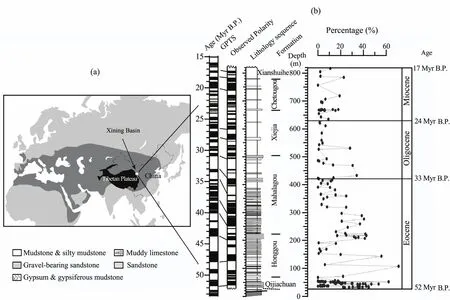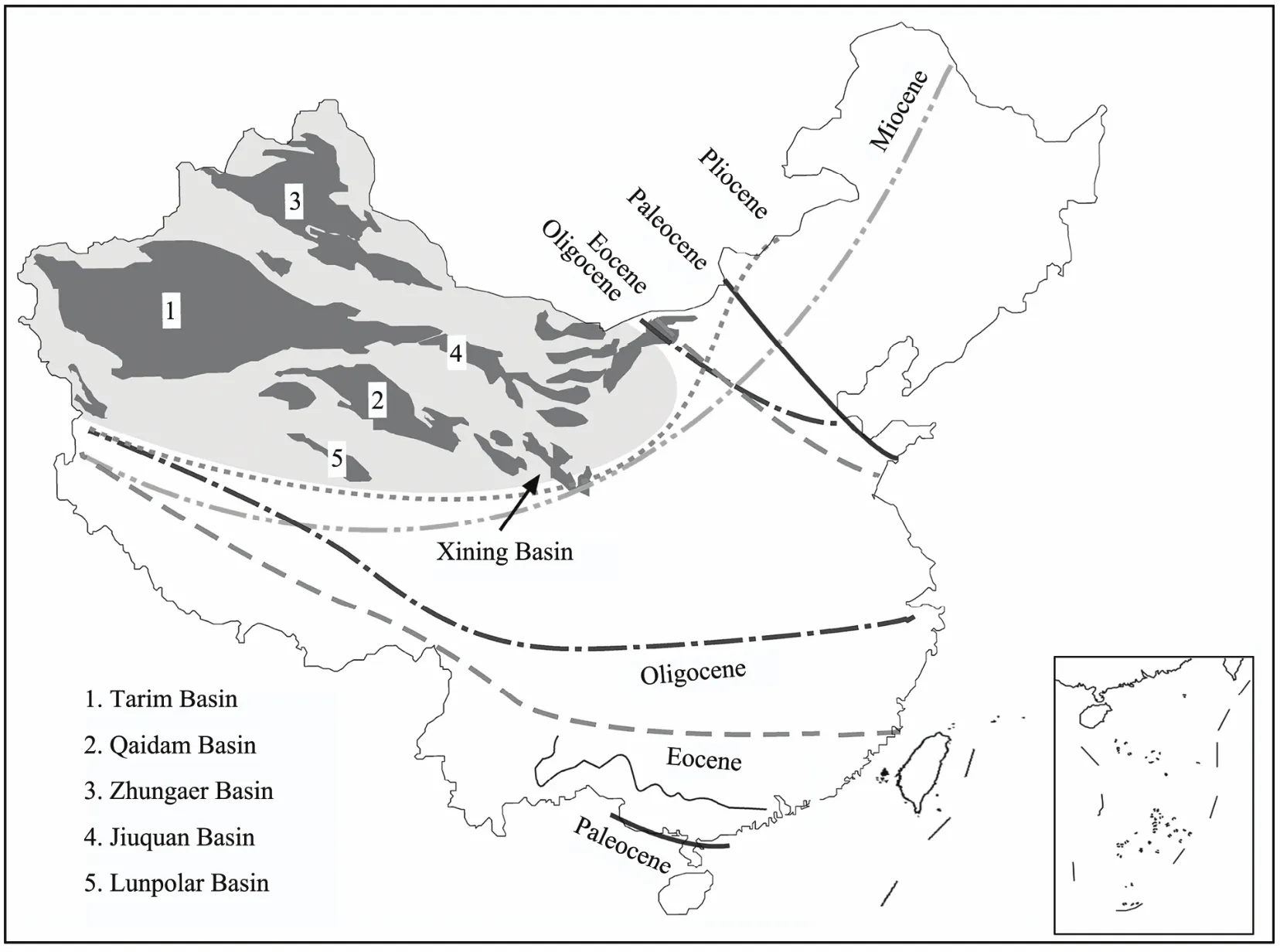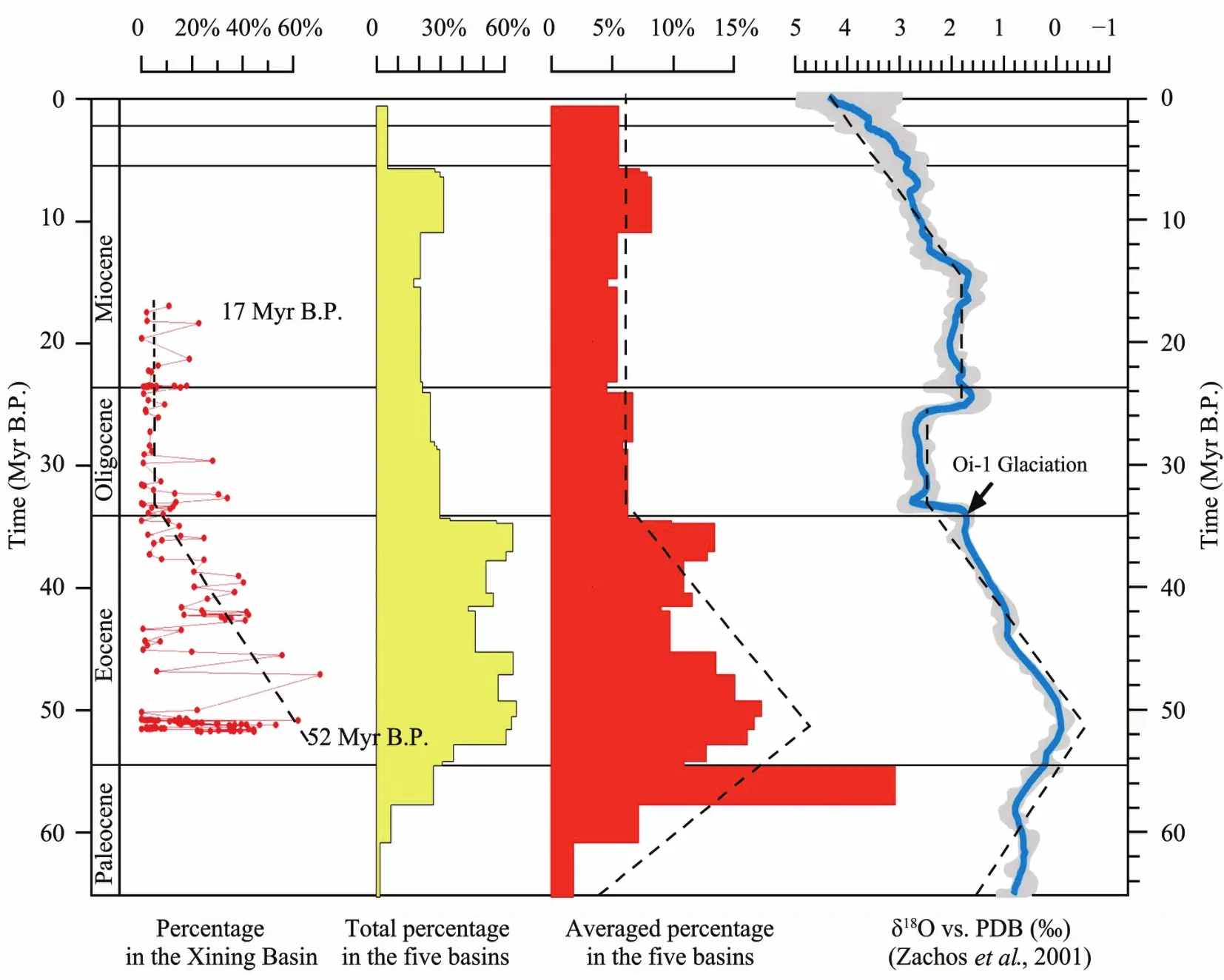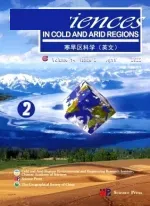Cenozoic Ephedraceae adaptation to global cooling in northwestern China
YunFa Miao , XiaoLi Yan , YaJun Shao , Bao Yang
1. Key Laboratory of Desert and Desertification, Cold and Arid Regions Environmental and Engineering Research Institute, Chinese Academy of Sciences, Lanzhou 730000, China
2. MOE Key Laboratory of Western China’s Environmental Systems & West Environment and Climate Changes Institute, Lanzhou University, Lanzhou 730000, China
Cenozoic Ephedraceae adaptation to global cooling in northwestern China
YunFa Miao1*, XiaoLi Yan2, YaJun Shao1, Bao Yang1
1. Key Laboratory of Desert and Desertification, Cold and Arid Regions Environmental and Engineering Research Institute, Chinese Academy of Sciences, Lanzhou 730000, China
2. MOE Key Laboratory of Western China’s Environmental Systems & West Environment and Climate Changes Institute, Lanzhou University, Lanzhou 730000, China
Ephedraceae has been applied largely as a drought indicator to reconstruct Cenozoic paleoenvironment and paleoclimate. However, temperature indication of Ephedraceae has been largely ignored. Here, we provide a record of Ephedraceae percentage spanning from the Early Eocene to Middle Miocene (52-17 Myr B.P.) in the Xining Basin, northeastern Tibetan Plateau. This record is comparable to a compiled Cenozoic Ephedraceae record from five other basins in northwestern China. Both records show Ephedraceae percentages were high during the Early Eocene, and decreased gradually from the Middle Eocene to Late Oligocene,then maintained a stable level since the Late Oligocene. By comparing these two Ephedraceae records with the marine oxygen isotope record, we discuss the variation of Ephedraceae percentage in Middle Cenozoic in response to global temperature change.Ephedraceae percentage was high in the Early Paleogene, associated with subtropical or tropical vegetation types in a global greenhouse climate, and decreased in Early Oligocene, associated with global cooling, suggesting that Ephedraceae is warm-tolerant during the Paleogene. The low Ephedraceae percentages in the Late Oligocene and Miocene were uncoupled with global warming, which may imply that Ephedraceae began to adapt to a eurythermic climate in the inland desert environment of western China. Such adaptation may be a response to the high topography of the Tibetan Plateau.
Ephedraceae; adaptation; temperature; Tibetan Plateau; Cenozoic
1. Introduction
Globally, Cenozoic climate shows a cooling trend starting from approximately 55 Myr B.P. and a series of dramatic cooling events (Zachosetal., 2001), which is linked with the accelerated rate of atmospheric CO2consumption of fast silicate weathering triggered by the Indo-Asian collision and associated tectonic events (e.g., Raymoetal., 1988; Raymo and Ruddiman, 1992; Edmond and Huh, 1997; Wallmann,2001). Regionally, uplift of the Tibetan Plateau and the Himalaya Mountains caused dramatic aridification in Central Asia and the onset of monsoonal climate in East Asia(Kutzbachetal., 1989; Ruddimanetal., 1989; Harris, 2006).Both global and regional climate changes were recorded in sediments, which may be revealed by climatic proxies (e.g.,δ18O values of carbonate; pollen).
Palynological analysis is a well-established method for reconstructing paleoclimate and paleoenvironment (e.g.,temperature, precipitation, and elevation), in which Ephedraceae percentage variation is very sensitive to dry climate and is usually attributed to dry conditions due to frequent association with other xerophillous shrubs (e.g.,Nitraria(Zygophyllaceae) and Chenopodiaceae) in arid and semiarid climates (e.g., Krutzsch, 1961; Gurevitchetal.,2002; Yang, 2002; Sun and Wang, 2005). This widely distributed type even became dominant in Cenozoic vegetation assemblages in northwestern China (e.g., Song, 1958; Songetal., 1999; Sun and Wang, 2005). For example, the highest percentages in the Qaidam Basin vary from 10% to 50% of pollen assemblages (Zhuetal., 1985). However, whether Ephedraceae percentage variation is also sensitive to temperature change, it has been ignored in many studies because of a lack of absolute age control (Wangetal., 1990) or low sampling density (Wangetal., 1990; Dupont-Nivetetal.,2008). In this paper, we address the temperature implication of Ephedraceae in the Cenozoic based on pollen records in northwestern China.
2. Modern Ephedraceae distribution
Ephedraceae is a desert perennial shrubby gymnosperm,which is mainly distributed in desert and grass zones of Asia,America, Southeastern Europe and Northern Africa (Figure 1a) (Gurevitchetal., 2002; Yang, 2002). Ephedraceae generally grows in arid climates, with very small leaves and low transpiration (Cutlar, 1939; Yang, 2002). In China,Ephedragrows where mean annual temperature (MAT) varies between -4 °C and 12 °C (Zhengetal., 2008), while in northern Africa (Sahara region), it grows where MAT is approximately 30 °C. Therefore, modern Ephedraceae belongs to eurythermic plants.

Figure 1 Modern Ephedraceae distribution (a) in Eurasian and African regions (grey area) (after Caveney et al., 2001) and (b) Ephedraceae percentage variation in the Xining Basin (palaeomagnetic age control is from Dai etal., 2006)
3. Geologic background, sampling method and results of the Xining Basin
Located in the northeastern Tibetan Plateau, the Xining Basin holds over 800-m thick lacustrine saline playa and distal alluvial fan deposits (Daietal., 2006). Previous palynological studies about the deposits show that the climate in this basin is consistent with Cenozoic global cooling (Wangetal., 1990) or strongly influenced by the uplift of the Tibetan Plateau (Dupont-Nivetetal., 2008). However, climate implications of the dominant species of Ephedraceae with nearly the highest percentages in the aforementioned studies were not well discussed. A more detailed palynological record is required to constrain regional climate and reveal Ephedraceae climate implication based on improved palaeomagnostratigraphy. A total of 123 pollen samples were collected through approximately 819-m thick Xiejia section in the Xining Basin (Longetal., 2011).
Our data provides a record of Ephedraceae percentage spanning the Early Eocene to Middle Miocene (52-17 Myr B.P.) (Daietal., 2006) in the Xining Basin (Figure 1b). During 52-33 Myr B.P., Ephedraceae percentage varied between 20% and 60%, with an average of 28%. Ephedraceae percentage dropped to approximately 20% at 33 Myr B.P. and maintained relatively constant after 33 Myr B.P.
4. Combined Ephedraceae records from five other basins in northwestern China
In Asia, climate transformation from a zonal pattern to a monsoon-dominated pattern occurred during the Miocene with the disappearance of typical subtropical aridity and the onset of inland deserts (Liuetal., 1998; Sun and Wang,2005; Guoetal., 2008). Before the Miocene, Ephedraceae was widely distributed in the subtropical arid zone throughout China and even reached to the northern South Yellow Sea Basin, and offshore western Korea (Yietal., 2003).Since the Miocene, the arid zone in Eastern China was replaced by monsoonal climate, and Ephedraceae percentage declined (with occasional occurrence of <1%) due to high precipitation brought by the Asian summer monsoon (Sun and Wang, 2005; Guoetal., 2008). Such precipitation change in the Cenozoic apparently affected Ephedraceae percentage in Eastern China. Therefore, to eliminate the humid response of Ephedraceae percentage, we compared our record of the Xining Basin with the combined Ephedraceae records from five other basins in northwestern China, all of which remained in a dry climate throughout the Cenozoic. These basins include the Tarim, Qaidam, Zhungaer, Jiuquan and Lunpolar basins (Figure 2), and age correlations are summarized in Sun and Wang (2005). Both the total and average percentages of Ephedraceae from the combined records were calculated from original data in the Tarim (Wang, 1990), Qaidam (Zhuetal., 1985), Jiuquan(Ma, 1993), Lunpolar (Song and Liu, 1982) and Zhungaer basins (Sun and Wang, 1990).
Ephedraceae percentage of the combined records shows that Ephedraceae percentage was high during the Paleocene and Eocene, then decreased dramatically during the Oligocene and remained low through the Miocene,which is similar to Ephedraceae percentage record in the Xining Basin.

Figure 2 Five basins always in the Cenozoic dry area (shallow grey) in northwestern China based on palynological and paleobotanical data (after Sun and Wang, 2005)
5. Discussion
The Ephedraceae record in the Xining Basin and the combined Ephedraceae records in northwestern China are generally comparable to the oxygen isotopic record of marine forams (Figure 3). The oxygen isotopic record of marine forams has been interpreted as a response to global temperature change, with higher δ18O values pointing to lower global temperatures (Zachosetal., 2001). The high Paleocene and Eocene Ephedraceae percentage is associated with low δ18O values, and the decrease of Ephedraceae percentage in Early Oligocene is coeval with an increase of δ18O values. Such co-variation suggests that variation of Ephedraceae percentage is coupled with global climate change in the Early Cenozoic, with high Ephedraceae percentage occurring in a greenhouse climate, and low Ephedraceae percentage in an icehouse climate during the Antarctic ice cap expansion. However,after the Late Oligocene, constant low Ephedraceae percentage was uncoupled with variation of the marine isotopic record, suggesting that Ephedraceae percentage was uncoupled with global warming in the Late Oligocene and cooling since the Middle Miocene (Figure 3). Therefore,Ephedraceae was warm-tolerant type vegetation during the Paleogene and adapted to a eurythermic environment since the Late Oligocene.
Cenozoic variation of Ephedraceae percentage in northwestern China is also associated with variation of major pollen and spores assemblages. Fossil Ephedraceae of gnetophyte pollen grains dates back to the Triassic, and most of the modern groups diversified within their clade during the Middle Cretaceous (approximately 100 Myr B.P.) and became widely distributed with high abundance from the Middle Cretaceous to Eocene (Campbell, 2002;Judd, 2002). During the warm climate of the Paleocene and Eocene, high percentages of Ephedraceae were always accompanied by a number of tropical or subtropical types of vegetation in six basins (Song and Liu, 1982; Zhuet al.,1985; Wangetal., 1990; Ma, 1993; Songetal., 1999).These vegetation types includeEngelhardtioipollenties(Engelhardtia),Sapotaceoidaepollenites(Sapotaceae),Liquidambarpollenites(Liquidambar),Magnolipollis(Magnoliaceae),Nyssapollenties(Nyssa),Ilexpollenite(Aquifoliaceae),Sapindaceidites(Sapindaceae),Podocarpidites(Podocarpaceae),Meliaceoidites(Meliaceae),Euphorbiacites(Euphorbiaceae),Rhoipites(Anacardiaceae)andRutaceoipollenites(Rutaceae). The high percentage of Ephedraceae and diversity of pollen types associated with abundant tropical and subtropical plant species suggest a warm climate during the Paleocene and Eocene. During the Oligocene, a decrease of Ephedraceae percentage was associated with the occurrence of various conifers, such asPinus,Picea,Abies,Cedrus,TsugaandCupressaceae, and C4plants,e.g., Chenopodiaceae and Compositae. The low Ephedraceae percentage during the Oligocene is associated with the low percentage of subtropical or tropical elements.Miocene pollen assemblages in northwestern China were more diversified than those during the Oligocene, where most subtropical or tropical elements disappeared. However, Ephedraceae percentage maintained low throughout the Late Oligocene up to the present, suggesting that Ephedraceae was uncoupled with local vegetation change.Therefore, pollen and spore assemblages in northwestern China also show that Ephedraceae was warm-tolerant during the Paleogene, and adapted to a eurythermic environment after the Late Oligocene.

Figure 3 Comparison between Cenozoic records of Ephedraceae percentages in the Xining Basin, combined records of Ephedraceae percentages in the five basins (Tarim, Qaidam, Jiuquan, Lunpolar and Zhungaer basins) in northwestern China with the δ18O record of marine forams (Zachos etal., 2001).
Uplift of the Tibetan Plateau and retreat of the epicontinental sea, which are closely linked to the Indo-Asian collision since approximately 55 Myr B.P., have triggered dramatic aridification and cooling of the Asian interior and the onset of the Asian monsoonal climate (Harris, 2006;Zhangetal., 2007). Modern East Asian monsoon system is initiated and established during the Miocene based on pollen-vegetation as well as other climatic proxies (Liuetal.,1998; Sun and Wang, 2005; Fanetal., 2006, 2007; Guoet al., 2008). We argue that warm-tolerant Ephedraceae began to inhabit a eurythermic environment since the Late Oligocene which was mainly driven by the uplift of the Tibetan Plateau.
The Tibetan Plateau progressively gained high elevation and expanded towards northwestern China since approximately 55 Myr B.P. (Tapponnieretal., 2001; Rowley and Currie, 2006; DeCellesetal., 2007; Wangetal., 2008; van der Beeketal., 2009). However, the uplift wasn’t significant enough to change the narrow climate arid belt stretching across China before the Oligocene (Sun and Wang, 2005;Guoetal., 2008). During global climate warming in the Late Oligocene and climatic optimum in Middle Miocene, high topography produced by the uplift of the Tibetan Plateau as well as enlargement of the land surface may have cooled down the interior of northwestern China, and initiated a topographic barrier for water vapor from the oceans. At the same time, Ephedraceae adapted to the cooling rather than migrating or extinction if its germ plasm can adapt itself to environmental change, and thus evolved to a eurythermal type which replaced the warm-tolerant vegetation type, but the exact timing is unclear.
6. Conclusions
The record of Ephedraceae percentage in the precisely dated Xining Basin and combined Ephedraceae records from five basins in northwestern China suggest that Ephedraceae was warm-tolerant during the Paleocene and Eocene, and adapted to a cooler climate since the Late Oligocene. The adaptation of Ephedraceae to a eurythermic environment since the Late Oligocene may be mainly driven by the uplift of the Tibetan Plateau.
This work is supported by NSFC Grants (40802041,41002050) and the Foundation for Excellent Youth Scholars of CAREERI, CAS (51Y184991). We thank Fan MJ for help in English improvement and two anonymous reviewers for their valuable comments and suggestions.
Campbell NA, Reece JB, 2002. Biology, 6thEdition. Benjamin Cummings,San Francisco.
Caveney S, Charlet DA, Freitag H, Maier-Stolte M, Starratt AN, 2001. New observations on the secondary chemistry of worldEphedra(Ephedraceae). American Journal of Botany, 88: 1199-1208.
Cutlar HC, 1939. Monograph of the North American species of the genusEphedra. Annals of the Missouri Botanical Garden, 26(4): 373-424, 426,428.
Dai S, Fang XM, Dupont-Nivet G, Song CH, Gao JP, Krijgsman W,Langereis C, Zhang WL, 2006. Magnetostratigraphy of Cenozoic sediments from the Xining Basin: Tectonic implications for the northeastern Tibetan Plateau. Journal of Geophysical Research—Solid Earth, 111:B11102. DOI: 10.1029/2005JB004187.
DeCelles PG, Quade J, Kapp P, Fan MJ, Dettman DL, Ding L, 2007. High and dry in central Tibet during the Late Oligocene. Earth and Planetary Science Letters, 253(3-4): 389-401.
Dupont-Nivet G, Hoorn C, Konert M, 2008. Tibetan uplift prior to the Eocene-Oligocene climate transition: evidence from pollen analysis of the Xining Basin. Geological Science of America, 36: 987-990.
Edmond JM, Huh Y, 1997. Chemical weathering yields from basement and orogenic terrains in hot and cold climates. In: Ruddiman WF (ed.). Tectonic Uplift and Climate Change. Plenum Press, New York. 330-350.
Fan MJ, Dettman DL, Song CH, Fang XM, Garzione CN, 2007. Climatic variation in the Linxia basin, NE Tibetan Plateau, from 13.1 to 4.3 Ma:The stable isotope record. Palaeogeography, Palaeoclimatology, Palaeoecology, 247(3-4): 313-328.
Fan MJ, Song CH, Dettman DL, Fang XM, Xu XH, 2006. Intensification of the Asian winter monsoon after 7.4 Ma: Grain-size evidence from the Linxia Basin, northeastern Tibetan Plateau, 13.1 Ma to 4.3 Ma. Earth and Planet Science Letters, 248(1-2): 186-197.
Guo ZT, Sun B, Zhang ZS, Peng SZ, Xiao GQ, Ge JY, Hao QZ, Qiao YS,Liang MY, Liu JF, Yin QZ, Wei JJ, 2008. A major reorganization of Asian climate by the early Miocene. Climate of the Past, 4: 153-174.
Gurevitch J, Schneider SM, Fox GA, 2002. The Ecology of Plants. Sinauer Associates, Inc., Sunderland MA.
Harris NBW, 2006. The elevation history of the Tibetan Plateau and its implications for the Asian monsoon. Palaeogeography, Palaeoclimatology, Palaeoecology, 241: 4-15.
Judd WS, 2002. Plant Systematics: A Phylogenetic Approach, 2ndEdition.Sinauer Associates, Inc., Sunderland MA.
Krutzsch W, 1961. Uber Funde von ''ephedroidem'' Pollen im deutschen Terti?r. Geologie, Beih 32: 15-53.
Kutzbach JE, Guetter PJ, Ruddiman WF, Prell WL, 1989. Sensitivity of climate to late Cenozoic uplift in southern Asia and the American West:numerical experiments. Journal of Geophysical Research, 94(D15):18393-18407.
Liu TS, Zheng MP, Guo ZT, 1998. Initiation and evolution of the Asian monsoon system timely coupled with the ice-sheet growth and the tectonic movements in Asia. Quaternary Sciences, 3: 194-204.
Long LQ, Fang XM, Miao YF, Bai Y, Wang YL, 2011. Northern Tibetan Plateau cooling and aridification linked to Cenozoic global cooling: Evidence from n-alkane distributions of Paleogene sedimentary sequences in the Xining Basin. Chinese Science Bulletin, 56(15): 1569-1578.
Ma JQ, 1993. The Tertiary sporopollen assemblage in the Jiuquan Basin and the palaeoenvironment. Petroleum Geology & Experiment, 15(4):423-435.
Raymo ME, Ruddiman WF, 1992. Tectonic forcing of late Cenozoic climate.Nature, 359: 117-122.
Raymo ME, Ruddiman WF, Froelich PN, 1988. Influence of late Cenozoic mountain building on ocean geochemical cycles. Geology, 16: 649-653.
Rowley DB, Currie BS, 2006. Palaeoaltimetry of the late Eocene to Miocene Lunpola basin, central Tibet. Nature, 439: 677-681.
Ruddiman W, Prell W, Raymo M, 1989. Late Cenozoic Uplift in Southern Asia and the American West: rationale for general circulation modeling experiments. Journal of Geophysical Research, 94(D15): 18379-18391.
Song ZC, 1958. Tertiary spores and pollen complex from the red beds of Jiuquan, Kansu and their geological and botanical significance. Acta Palaeontol. Sin., 6(2): 159-167.
Song ZC, Liu GW, 1982. Early Tertiary Palynoflora and its significance of Palaeogeography from Northern and Eastern Xizang. In: Team of Comprehensive Scientific Expedition to the Qinghai-Xizang Plateau, Academia Sinica (Eds.). Palaeontology of Xizang. Science Press, Beijing.165-190.
Song ZC, Zheng YH, Li MN, 1999. Fossil spores and pollen of China (I):Late of Cretaceous-Tertiary spores and pollen. Science Press, Beijing.749-757.
Sun MR, Wang XZ, 1990. Tertiary palynological assemblages from the Junggar Basin, Xinjiang. In: Institute of Geology, Chinese Academy of Geological Sciences, Research Institute of Petroleum Exploration and Development, Xinjiang Petroleum Administration (Eds.). Permian to Tertiary Strata and Palynological Assemblages in the North of Xinjiang.China Environmental Science Press, Beijing. 122-151.
Sun XJ, Wang PX, 2005. How old is the Asian monsoon system? Palaeobotanical records from China. Palaeogeography, Palaeoclimatology,Palaeoecology, 222: 181-222.
Tapponnier P, Xu Z, Palmer TN, Shukla J, Tomas RA, Yanai M, Yasunari T,2001. Oblique stepwise rise and growth of the Tibetan Plateau. Science,294: 1671-1677.
van der Beek PA, Van Melle J, Guillot S, Pêcher A, Reiners PW, Nicolescu S, Latif M, 2009. Eocene Tibetan Plateau remnants preserved in the northwest Himalaya. Nature Geoscience, 2: 364-368.
Wallmann K, 2001. Controls on the Cretaceous and Cenozoic evolution of seawater composition, atmospheric CO2, and climate. Geochimica et Cosmochimica Acta, 65: 3005-3025.
Wang CS, Zhao XX, Liu ZF, Lippert PC, Graham SA, Coe RS, Yi HS, Zhu LD, Liu S, Li YL, 2008. Constraints on the early uplift history of the Tibetan Plateau. Proceedings of the National Academy Sciences of the United States of America, 105: 4987-4992.
Wang DN, Sun XY, Zhao YN, 1990. Late Cretaceous to Tertiary palynofl oras in Xinjiang and Qinghai, China. Review of Palaeobotany Palynology,65: 95-104.
Yang Y, 2002. Systematic and evolution ofEphedra L. (Ephedraceae) from China. PhD Thesis, Institute of Botany Chinese Academy of Sciences,Beijing. 1-231.
Yi S, Yi S, Batten DJ, Yun H, Park SJ, 2003. Cretaceous and Cenozoic non-marine deposits of the Northern South Yellow Sea Basin, offshore western Korea: palynostratigraphy and palaeoenvironments. Palaeogeography, Palaeoclimatology, Palaeoecology, 191: 15-44.
Zachos JC, Pagani M, Sloan L, Thomas E, Billups K, 2001. Trends, rhythms,and aberrations in global climate 65 Ma to present. Science, 292:686-693.
Zhang ZS, Wang HJ, Guo ZT, Jiang DB, 2007. What triggers the transition of palaeoenvironmental patterns in China, the Tibetan Plateau uplift or the Paratethys Sea retreat? Palaeogeography, Palaeoclimatology, Palaeoecology, 245: 317-331.
Zheng Z, Huang KY, Xu QH, Lu HY, Cheddadi R, Luo YL, Beaudouin C,Luo CX, Zheng YW, Li CH, Wei JH, Du CB, 2008. Comparison of climatic threshold of geographical distribution between dominant plants and surface pollen in China. Science in China (Series D: Earth Science),51(8): 1107-1120.
Zhu ZH, Wu LY, Xi P, Song ZC, Zhang YY, 1985. A Research on Tertiary Palynology from the Qaidam Basin, Qinghai Province. Petroleum Industry Publishing House, Beijing. 1-41.
10.3724/SP.J.1226.2011.00375
*Correspondence to: Dr. YunFa Miao, Cold and Arid Regions Environmental and Engineering Research Institute, Chinese Academy of Sciences. No. 320, West Donggang Road, Lanzhou, Gansu 730000, China. Tel: +86-931-4967544; Email: miaoyunfa@lzb.ac.cn
24 March 2011 Accepted: 15 June 2011
 Sciences in Cold and Arid Regions2011年5期
Sciences in Cold and Arid Regions2011年5期
- Sciences in Cold and Arid Regions的其它文章
- Satellite dataset analysis of recent vegetation variation in Tibet region
- Research progress in cold region wetlands, China
- Relationship analysis between September precipitation in western China and 700 hPa wind field in East Asia
- Characterization and quantification of within-year variation of snow-cover elevation in mountainous regions, eastern Tibet
- Influence of air masses on particle number concentration and size distribution at Mt. Waliguan, Qinghai Province, China
- Environmental records of snow pits in Yuzhufeng Glacier and Xiao Dongkemadi Glacier in the Tibetan Plateau
